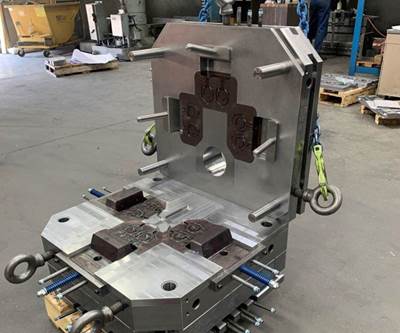What Comes Next: The Beginning of a Reshoring Policy for U.S. Manufacturing
The current crisis is a reckoning. Right now, the challenge is saving livings. But once we are free to look ahead, let’s learn the lessons and prepare ourselves better for the next crisis that comes.
Share




We are hoping manufacturing saves lives. That is the situation as I write these words. We are in the midst of the coronavirus crisis. A question still unanswered: Will there be enough ventilators to meet the needs of the most serious COVID-19 sufferers? We do not know. Machining suppliers are doing their part, with many shops now devoting much or all their attention and capacity to ventilator component production, and many more will likely enter the effort soon. In the race between production and infection, we are all rooting for production and our champion might yet win.
But still, there is a sense in which we have already accepted a sort of defeat. I am writing these words from my home. Most businesses have closed or vacated their facilities. We have shut ourselves in, sworn off the joys of a free, open and advanced society, all because of a legitimate fear. We are hiding from a virus in order to slow the spread because we know we are short on supplies to treat the sufferers, and we fear our manufacturing capabilities might not actually be able to keep up.
Did it have to be this way? To an extent, yes. The race to produce more ventilators would have been an unprecedented challenge no matter what. However, certain aspects of the response reveal our vulnerabilities. The reinvention of the supply chain did not have to be as drastic as it appears to have been. In the future, our ability to respond can be what we would have hoped for it to be this year.
While we can’t predict the next threat, we know it likely will have this much in common with the crisis today: Some vital object will be part of the answer … and our ability to produce that item quickly will determine the success of our response.
The challenge here and now is to meet the urgent medical need. Ignore and delay everything else. Yet nearly all of us in manufacturing can sense the bigger, broader, farther-reaching challenge coming next. The current situation is a reckoning, one that many have foreseen and sought to warn against. In manufacturing, we have allowed buffers and margins to become too lean, supply lines to stretch too far, and pennies to be pinched too tightly. Another crisis is coming at some point. And while we don’t know what it will be, we know it likely will have this much in common with the crisis today: Some vital object will be part of the answer — a tool, a machine, a piece of technology — and our ability to produce that item quickly and in large quantities will determine the success of our response. We support manufacturing in part because, in extreme times, manufacturing saves us.

Seeing this, it is time for the United States, as a matter of policy, to recognize the importance of domestic manufacturing. To support, value and encourage not just manufacturing in general, but the development of a sophisticated manufacturing base as a vital matter of national security and — as we are seeing — national health.
This is not a new idea. Words like these have been written before. What is new are the fresh lessons we will bring out of this time.
So how do we begin?
The contents and priorities of a U.S. domestic manufacturing policy in the wake of the lessons of 2020 are an area I want to weigh in on and discuss with others. Soon. For now, the question I want to explore is simply how and where to begin. And I think this crisis has given us the clue.
It happened at the state level. It happened as we began to shut ourselves in. Within the different states, as one governor after another issued different shadings of stay-at-home orders or recommendations, many of us learned for the first time of the notion of “essential” versus “non-essential” businesses. Plenty of businesses have gone dark during the crisis, but plenty also have remained open, their employees still showing up, because someone made a list (however imperfect) of the categories of business that needed to keep operating.
Essential, non-essential — I believe the starting point is a definition like this at the federal level around manufactured products. We cannot predict the next crisis, but we can imagine scenarios. We can imagine what devices we might need if one perilous scenario after another comes upon us. We can therefore imagine which stocks of equipment we never again want to see depleted, and which supply lines would be the worst to have cut.
Manufacturers of essential products would define and certify how production will be protected or expanded in a time of crisis, or when the normal rate of production is suddenly too small. This obligation would tend to necessitate domestic sourcing.
For the manufacturers of products deemed essential, things would change. The designation would be privileged; it would come with support, benefits or protections. It would have to do so, because the designation will also bring a burden. Manufacturers of products classified as essential would be required to define and certify how production will be protected or expanded in a time of crisis when supply is interrupted, or when the normal rate of production is suddenly too small. This obligation would tend to necessitate domestic sourcing. This designation would thus be the start of an official policy of reshoring vital U.S. manufacturing. It means low cost (or a low visible cost) could no longer be the ultimate determinant of where production occurs or how it is organized. This would amount to a deep and fundamental shift — and this change alone might do a great deal to stimulate and provide context for all the other changes to U.S. manufacturing that ought to come.
Other changes worthy of discussion may or may not suggest policy choices. For example, a reshoring strategy must be coupled to a digital manufacturing strategy, because our energy has to flow toward cultivating nimble and competitive manufacturing rather than protecting legacy facilities and methods. And additive manufacturing in particular should be embraced, because this could bring us a nationwide distributed manufacturing network that would be the most responsive manufacturing resource of all in a time of crisis. Let’s explore this soon. Let’s hope the chance to do so comes quickly.
For now, we look to manufacturing to help allow as many as possible to join us in that discussion. And we extend our gratitude toward the physicians and healthcare professionals who are working even harder than manufacturers, putting to good use all the tools manufacturing is able to provide.
Read Next
Aerospace Supplier Shifts to Tight-Tolerance Ventilator Parts: "We Weren't in This Business Two Weeks Ago"
Skilled Manufacturing Inc. is running seven days a week to produce ventilator parts that will help healthcare workers battle the coronavirus.
Read MoreDoes Asia's Low-Cost Manufacturing Option Still Make Sense?
As U.S.-based companies try to stay ahead of COVID-19, global supply chains are under renewed scrutiny. Are uncertainties and delays caused by global crises worth the short-term cost savings?
Read MoreDie Maker Describes Five-Day Build for Tool Urgently Needed for Coronavirus Ventilator Production
Running 11 five-axis machines simultaneously, a die maker reduced a five week lead time to just five days. Here’s how.
Read More



























